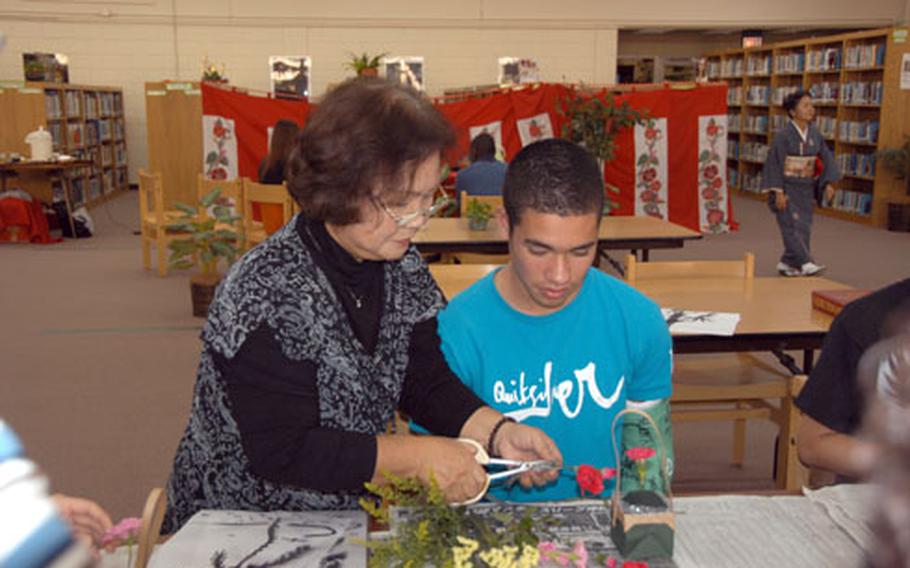
Instructor Sachiko Takaesu helps senior Danny Fisher, 17, cut carnations for a flower arrangement Thursday at Kubasaki High School. Fisher and classmates from his sociology class were learning Japanese flower arrangement, or ikebana, as part of a cultural activity day. (Photos by Natasha Lee/Stars and Stripes)
CAMP FOSTER, Okinawa — Sociology students at Kubasaki High School practiced Asian calligraphy and flower arranging Thursday during a cultural activity day designed to introduce Japanese traditions.
The event was the culmination of the class’ focus on the customs and traditions surrounding different cultures, and how they affect society, said sociology teacher Megan Youness.
Junior Vanessa Wester, 16, said the art of writing calligraphy wasn’t as easy as it looked, but she was encouraged.
"You have to do it with body movement, and it’s hard," she said. "But I think it would be fun to take an actual class."
Students also tried sumi-e, or ink painting; origami; and the rituals of a Japanese tea ceremony.
Local Okinawan instructors volunteered their time Thursday to teach the students.
Youness said part of the goal is to introduce Okinawan customs to students who don’t always get to experience life outside a military base.
This is the second year Youness has organized a cultural day for her sociology class, she said.
"If students are studying culture, they should know the culture they’re living in," she said.
But for some students, she said, exploring Okinawan culture can be difficult.
School activities, homework and life can get in the way. Teens have to rely on their parents for transportation off base and into town to check out festivals, shops and historical sites, Youness said.
And there’s also parental concern about responsibility and independence.
"My parents worry a lot about safety," said junior Kendra LaPan, 17. "For me, I’d actually love to go out in town and try on a kimono or get into a Japanese lifestyle for a day. It’s just time-consuming."
Others say they make an effort to familiarize themselves with Okinawan neighborhoods and restaurants.
Sophomore Jessica Herrera, 15, who has lived on Okinawa for six years, said she and her friends enjoy frequenting shops and stopping for coffee at Japanese cafes near Sunabe.
"We like to walk from Foster to Kadena and shop in between," she said.
Senior James McDowell, 17, said the activities gave him a glimpse of Okinawan history and tradition that he wouldn’t usually participate in.
"Sushi is about as cultural as I’ve gotten," said McDowell, who’s lived on Okinawa for nearly seven years.
He’s visited the island’s tourist sites, like the Pineapple Factory in Nago, and attended festivals, but he says the island’s Americanized appearance can overshadow cultural experiences.
"I don’t really see much tradition," he said. "I see more modern times when I’m out in town."